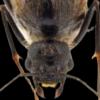1. Drosophila hydei are a larger than Drosophila melanogaster (roughly 1/8 of an inch compared to 1/16 of an inch). They are two separate species and technically no one is better than the other. The larger ones (hydei) reproduce slower but are more food per fruit fly, while the smaller ones (melanogaster) reproduce faster but each fruit fly isn't as much food for the ants. I've only ever bought melanogaster as food for my semi-claustral queens, but I think I'll be getting hydei next time because I believe they would be able to carry them and it would be easier for me to manage and see.
2. Flightless fruit flies have wings but they can't fly, wingless fruit flies don't have wings so they can't fly as well. I believe both are caused by a genetic mutation that either deforms the wings, the wing muscles, or causes them not to grow at all. I believe hydei only have flightless strains while melanogaster has both flightless and wingless strains but I'm not sure about that. Either way, they can't fly.
3. To make sure only a few get out, you can gently tap the bottom of the container against the top of a table to knock them all down to the very bottom, then tip it over where you want them to fall into, then either shake it a bit or tap it while it's upside down to get them to fall out. Just make sure that they don't have time to run out of wherever you are knocking them into. I just tap them into a small rectangular container, then close their tube, then cap the container and freeze it. You can also put the fruit fly culture into the fridge for a short amount of time (maybe 5 minutes) to slow them down and make them easier to manage.
Edited by Reevak, January 3 2018 - 6:26 PM.





















